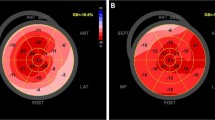Abstract
Purpose In this study, demographic, clinic, electrocardiographic and angiographic properties of patients, on whom coronary angiography was performed with the pre-diagnosis of coronary artery disease (CAD) and whose ventriculography demonstrated typical apical hypertrophic cardiomyopathy (AHCM), were investigated. Methods Seventeen patients (mean age 58 ± 10 years, 10 male) with CAD pre-diagnosis, on whom coronary angiography was performed and had typical spade-like appearance on left ventriculography, were included in the study between January 2000 and May 2005. Results As risk factor for CAD, 8 (47%) patients had hypertension, 8 (47%) patients had dyslipidaemia, 2 (11%) patients had type 2 diabetes mellitus, 13 (77%) patients had a history of smoking, and 2 (11%) patients had family history. Seven (42%) patients presented unstable angina pectoris, 8 (47%) patients presented stable angina pectoris and 2 (11%) patients were asymptomatic. On coronary angiography, it was determined that 10 (58%) patients had normal coronary arteries, 3 (17%) patients had non-significant stenosis and 4 (25%) patients had myocardial bridging. Five (30%) patients revealed mid-ventricular obstruction and intraventricular gradient was 25 ± 5 mmHg by the catheterization. All patients showed ‘‘giant’’ negative (≥ 10 mm) T waves in the precordial leads, whereas 2 patients had atrial fibrillation. Maximum wall thickness was measured as 18 ± 4 mm in the apical region by transthoracic echocardiography. One patient (5%) who had mid-ventricular obstruction developed atrial fibrillation during 2 years follow-up, though any other events did not occur during hospitalization or follow-up period. Conclusions Physicians caring for patients with chest pain should consider AHCM in their differential diagnosis in case of a patient with chest pain and electrocardiographic changes suggestive of CAD.


Similar content being viewed by others
References
Maron BJ (2002) Hypertrophic cardiomyopathy: systematic review. JAMA 287:1308–1320
Sakamoto T, Tei C, Murayama M et al (1976) Giant T wave inversion as a manifestation of asymmetrical apical hypertrophy (AAH) of the left ventricle: echocardiographic and ultrasono-cardiotomographic study. Jpn Heart J 17:611–629
Yamaguchi H, Ishimura T, Nishiyama S et al (1979) Hypertrophic nonobstructive cardiomyopathy with giant negative T waves (apical hypertrophy): ventriculographic and echocardiographic features in 30 patients. Am J Cardiol 44:401–412
Sakamoto T (2001) Apical hypertrophic cardiomyopathy (apical hypertrophy): an overview. J Cardiol 37(suppl I):161–178
Duygu H, Zoghi M, Nalbantgil S et al (2007) Myocardial bridge: a bridge to atherosclerosis. Anadolu Kardiyol Derg 7(1):12–16
Schiller NB, Shah PM, Crawford M et al (1989) Recommendations for quantitation of the left ventricle by two-dimensional echocardiography. American Society of Echocardiography Committee on Standards, Subcommittee on Quantitation of Two-Dimensional Echocardiograms. J Am Soc Echocardiogr 2(5):358–367
Abinader EG, Rauchfleisch S, Naschitz J (1982) Hypertrophic apical cardiomyopathy: a subtype of hypertrophic cardiomyopathy. Isr J Med Sci 18:1005–1009
Steingo L, Dansky R, Pocock WA et al (1982) Apical hypertrophic nonobstructive cardiomyopathy. Am Heart J 104:635–637
Kitaoka H, Doi Y, Casey SA et al (2003) Comparison of prevalence of apical hypertrophic cardiomyopathy in Japan and the United States. Am J Cardiol 92(10):1183–1186
Abinader EG, Sharif D, Shefer A et al (2002) Novel insights into the natural history of apical hypertrophic cardiomyopathy during long-term followup. Isr J Med Sci 4:166–169
Kereiakes DJ, Anderson DJ, Crouse L et al (1983) Apical hypertrophic cardiomyopathy. Am Heart J 05:855–856
Webb JG, Sasson Z, Rakowski H et al (1990) Apical hypertrophic cardiomyopathy: clinical follow-up and diagnostic correlates. J Am Coll Cardiol 15:83–90
Harada K, Shimizu T, Sugishita Y et al (2001) Hypertrophic cardiomyopathy with midventricular obstruction and apical aneurysm. Jpn Circ J 65:915–919
Fighali S, Krajcer Z, Edelman S et al (1987) Progression of hypertrophic cardiomyopathy into a hypokinetic left ventricle: higher incidence in patients with midventricular obstruction. J Am Coll Cardiol 9:288–294
Keren G, Belhassen B, Sherez J et al (1985) Apical hypertrophic cardiomyopathy: evaluation by noninvasive and invasive techniques in 23 patients. Circulation 71:45–56
Layher JW, Sawada SG (1997) Apical hypertrophic cardiomyopathy. ACC Curr J Rev 6(2):90–92
Möhlenkamp S, Hort W, Ge J et al (2002) Update on myocardial bridging. Circulation 106(20):2616–2622
Zoghi M, Duygu H, Nalbantgil S et al (2006) Impaired endothelial function in patients with myocardial bridge. Echocardiography 23(7):577–581
Duygu H, Zoghi M, Nalbantgil S et al (2008) High-sensitivity C-reactive protein may be an indicator of the development of atherosclerosis in myocardial bridging. Int J Cardiol 124(2):267–270
Eriksson MJ, Sonnenberg B, Woo A et al (2002) Long-term outcome in patients with apical hypertrophic cardiomyopathy. J Am Coll Cardiol 39:638–645
Author information
Authors and Affiliations
Corresponding author
Rights and permissions
About this article
Cite this article
Duygu, H., Zoghi, M., Nalbantgil, S. et al. Apical hypertrophic cardiomyopathy might lead to misdiagnosis of ischaemic heart disease. Int J Cardiovasc Imaging 24, 675–681 (2008). https://doi.org/10.1007/s10554-008-9311-7
Received:
Accepted:
Published:
Issue Date:
DOI: https://doi.org/10.1007/s10554-008-9311-7




